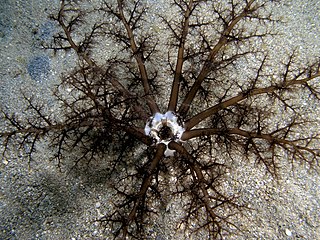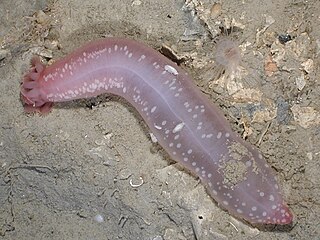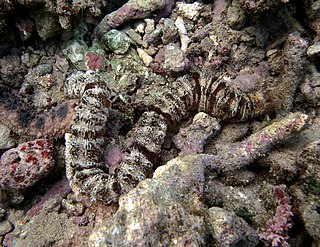
Apodida is an order of littoral to deep-sea, largely infaunal holothurians. This order comprises three families, 32 genera and about 270 known species, called apodids.

Holothuria is the type genus of the marine animal family Holothuriidae, part of the class Holothuroidea, commonly known as sea cucumbers. Members of the genus are found in coastal waters in tropical and temperate regions. They are soft bodied, limbless invertebrates that dwell on the ocean floor and are usually detritivore. They resemble a cucumber in form. The genus contains some species that are harvested and sold as food.

Iravadiidae is a family of minute sea snails, marine gastropod molluscs in the superfamily Truncatelloidea and the clade Littorinimorpha.

Austromitra is a genus of sea snails, marine gastropod mollusks in the family Costellariidae.

Rissoina is a large genus of minute sea snails, marine gastropod mollusks or micromollusks, in the family Rissoinidae.

Synaptidae is a family of sea cucumbers that have no tube feet, tentacle ampullae, retractor muscles, respiratory trees, or cuvierian tubules. They also lack radial canals of the water-vascular system, with only the circumoral ring present.

Synaptula is a genus of sea cucumbers, containing the following species:

Cucumariidae is a family of sea cucumbers, marine animals with elongated bodies, leathery skins and tentacles that are found on the sea bed.

Caudinidae is a family of sea cucumbers, marine animals with elongated bodies, leathery skins and tentacles that are found on the sea floor.

Mycalidae is a family of marine demosponges.

Leptasterias is a genus of starfish in the family Asteriidae. Members of this genus are characterised by having six arms although five-armed specimens sometimes occur. L. muelleri is the type species. The taxonomy of the genus is confusing and Leptasterias hexactis seems to be a species complex. Some species brood their eggs.

Sclerodactylidae is a family of sea cucumbers, marine invertebrates with elongated bodies, leathery skins and tentacles.

Phyllophoridae is a family of sea cucumbers, marine invertebrates with elongated bodies, leathery skins and feeding tentacles.

Entocolax is a genus of sea snails, marine gastropod mollusks in the family Eulimidae.
Entocolax schwanitschi is a species of sea snail, a marine gastropod mollusk in the family Eulimidae.

Chiridotidae is a family of sea cucumbers.

Chiridota is a genus of sea cucumbers in the family Chiridotidae. It is an extant genus but some fossil species are known.

Euapta is a genus of sea cucumbers in the family Synaptidae.

Opheodesoma is a genus of sea cucumbers in the family Synaptidae.

Psolus is a genus of sea cucumbers in the family Psolidae, marine animals with long bodies, leathery skins and tentacles, that inhabit the sea bed.

















